The picturesque Canal de Briare, which connects the valleys of the Seine and the Loire, is notable for a number of reasons apart from the delightful scenery through which it wends its way. A popular route for both private and commercial cruising vessels, the canal is renowned as one of the loveliest places for a barge cruise as well as being a highly impressive feat of engineering.
The Ultimate Guide to the Canal de Briare: One of the Oldest French Canals
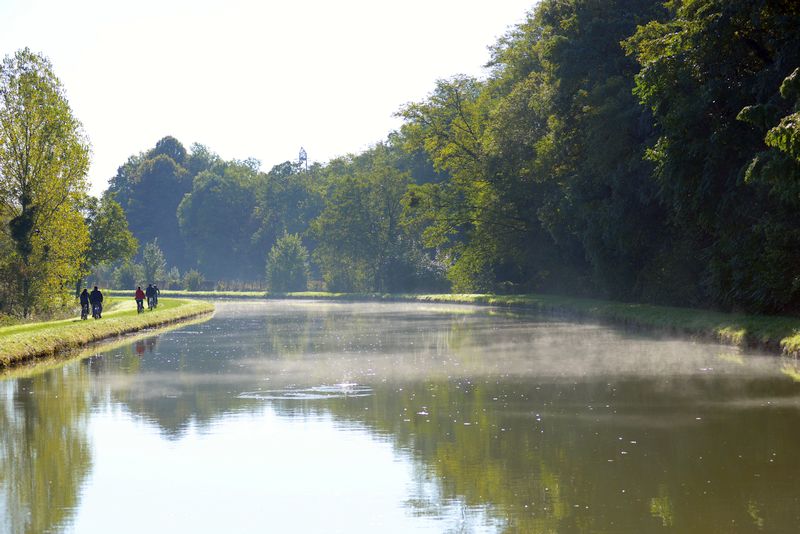
A Pioneering History
The first summit-level canal in Europe, the Canal de Briare (35 miles – 35 locks) joins the Loire to the Seine via the Loing River. On the Seine side, 24 locks make up for a difference in height of 252 feet, and on the Loire side, 12 locks make up for a difference of 135 feet.
The Canal was first considered by Maximilien de Béthune, King Henry IV’s first minister and the Duke of Sully, as a way of getting produce from the Loire Valley and Gâtinais to Paris quickly and efficiently. In the 17th century Paris was booming and its population were hungry. A canal linking the food-bowl of France with a growing metropolis would cut the food shortages Paris was experiencing, and would also both provide the local area with employment and the King with taxes.
Henry IV was satisfied with the plans and, in 1604, awarded the project to the engineer Hughes Cosnier. Work started on building the canal and 12,000 workers toiled to dig the canal by hand.
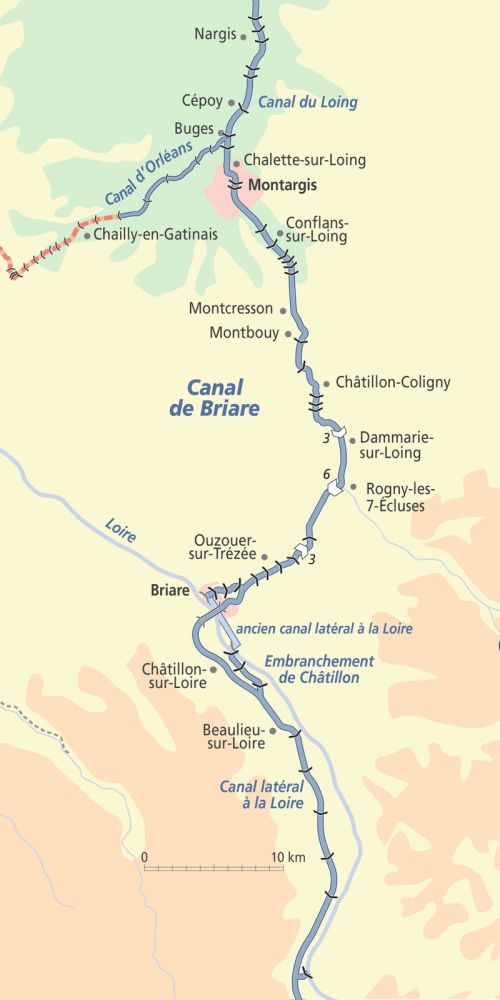
An Engineering Triumph
The Canal de Briare was also the first to be constructed at summit level using “pound locks“, which feature a chamber with gates at either end to control the height of the water within. (Before then locks were created with a single gate.) A summit level canal first rises and then falls along its course, and in the case of the 57km Canal de Briare, it rises through 12 locks before falling through another 24 on an 85m descent.
During construction a number of artificial lakes were created in order to feed water into the locks. At the most precipitous location, Rogny, it was necessary to build what was in effect a “staircase” of seven locks in order to navigate the fall of the canal. While it was without a doubt an outstanding feat of engineering, the design caused huge hold-ups as each vessel had to navigate all seven locks before the next was able to pass through. In the end the staircase of locks was abandoned and the canal re-routed to bypass them, but the town was later renamed Rogny-les-Sept-Ecluses in their honour.
The assassination of the King in 1610 halted construction, but in 1620 Cosnier was invited to continue the ambitious project. In 1629 Cosnier died, however Guillaume Boutheroue took charge of the project and the canal was completed in 1648.
Unlike the Canal du Loing, which follows a river its whole length, the Canal de Briare is a watershed canal. Although supplied by carefully designed reservoirs, the canal did suffer from water shortages when it first opened. In the late 19th century, the canal was diverted over the River Loire with the construction of the Briare Aqueduct.
The Canal de Briare begins just north of Montargis at Buges. The section of the canal between Montargis and Rogny follows the valley of the River Loing. Many of the villages and hamlets date from earlier times than the origin of the canal.
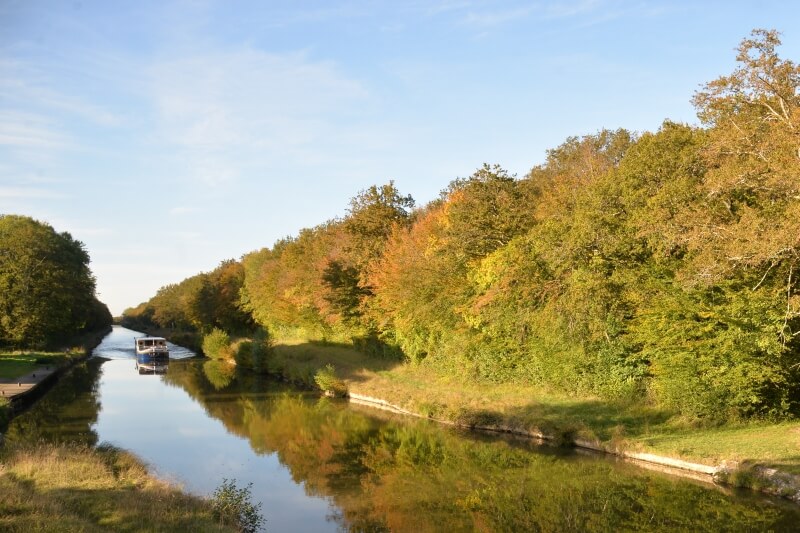
Towns & Villages along the Canal de Briare
Montargis is one of the villes fleuries, a designation awarded to towns and villages with fabulous floral displays. Also known as the “Little Venice of France”, this lively and attractive town is dissected by many small canals. The Canal de Briare wends its way right through the centre of town, with its banks alongside the back of the 17th century houses. The town’s museums provide a wealth of information on local arts and traditions. During the reign of Louis XIII, a local chef invented a confection made from roasted almonds covered with sugar, which became known as pralines.
The origins of Montcresson are uncertain, however two relics of early an settlement including a pierced stone and a tumulus (an ancient burial mound) have been found in the vicinity. Within the town itself, several buildings including the church, castle and a former convent are attributed to the 13th century. The convent and the 12th century church of Saint-Léger were linked by an underground tunnel, which still exists today.
Montbouy houses a 2nd century Gallo-Roman bath house and an amphitheatre which had a capacity of 4000, the remains of which were uncovered by engineers during the construction of the canal. The 11th century church has seen many alterations since its construction, the last being in the 17th century. It was added to the list of Historic Monuments in 1967. Originally there were two locks here separated by a little lake. They were replaced in 1892 by one lock. One of the old locks without its gates can still be seen today.
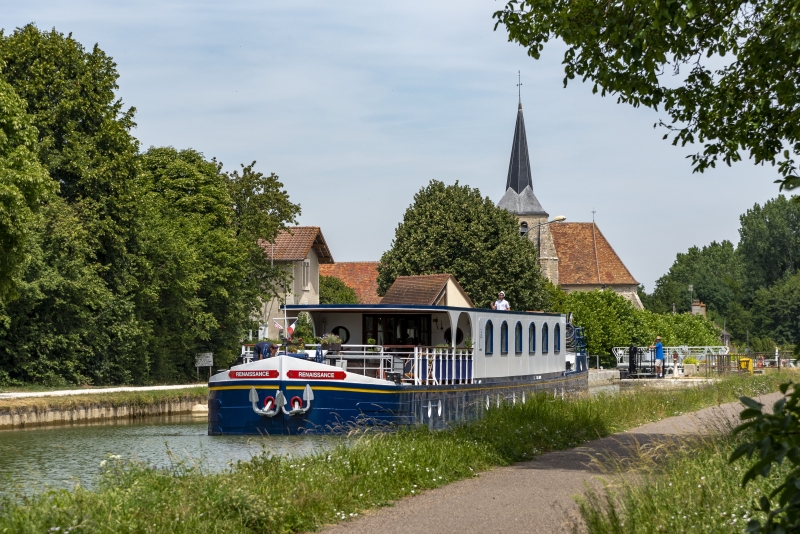
Châtillon-Coligny, as the town of Châtillon has been known since 1896, entered the ownership of the Coligny family in 1437. Because the four Coligny sons were Protestant, the town suffered during the Wars of Religion which began with overt hostilities in 1562 and lasted until the Edict of Nantes in 1598. Admiral de Coligny, the chief of the Huguenots, was murdered in Paris as part of targeted assassinations and a wave of Catholic mob violence directed against protestants by order of the Queen, Catherine de’ Medici, during the Religious Wars, in what was later called the St-Bartholomew’s Day Massacre. “Une foi, une loi, un roi” (one faith, one law, one King) left little room for religious tolerance.
The place still retains some of the atmosphere of a medieval town, including the original wash houses where the inhabitants scrubbed their washing in the river. A superb 12th century château, built by the Count of Sancerre, used to stand in Châtillon-Coligny but was destroyed in 1799 during the French Revolution. All that remains are three monumental terraces, the, orangerie and an impressive sixteen-sided dungeon.
In modern history, the settlement received some fame in 1903 when Henri Becquerel won the Nobel Prize for Physics for the discovery of natural radioactivity.
Rogny-les-Sept-Écluses is at the bief de partage, or watershed, of the Canal de Briare. Here the canal leaves the valley of the Loing, climbs towards its highest point, crosses a small marshy plain, and begins the descent to the Loire. Near Rogny, 15 reservoirs were dug to provide water for this section.

In order to extend the Canal de Briare out of the Loing Valley, it was necessary to build a linked series of locks. In 1642, the famous seven lock staircase opened and worked without interruption for two centuries. On average, the locks passed around 4,000 boats and 200,000 tons of cargo per year.
In 1880 the seven locks were replaced by the current six in the Freycinet gauge. Separated about 500 meters from each other, the new locks bypass the hill and, since 1887 the old locks, too small and too water consuming, were abandoned. The seven locks were made a historic monument in 1983. Rogny changed its name to Rogny-les-Sept-Écluses in 1978 to mirror its famous monument.
Located close to the summit of the Canal de Briare, La Gazonne is surrounded by the reservoirs and ponds that feed the canal. La Gazonne is the largest such lake.
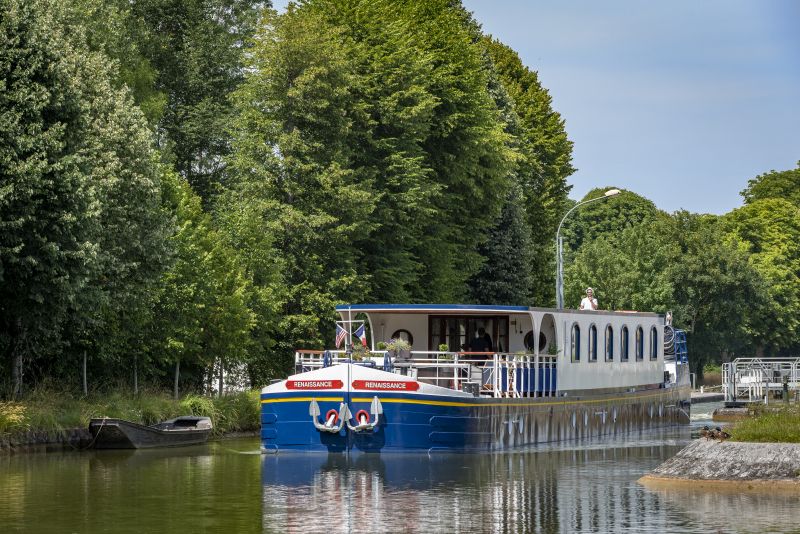
Briare is one of the largest towns in the Loiret and is the town from which the Canal de Birare takes its name. Relatively modern by French standards, the town was founded with the building of the Canal de Briare in the 17th century. Opposite the commercial port, a series of buildings and chimneys are all that remain of the tile and button factory that once occupied the site. The Émaux de Briare was founded by the 19th century French business magnate Jean-Félix Bapterosses in 1837 and in 1851 exhibited its wares at the Great Exhibition in London. Still operating, although not from Briare, the company sells its mosaics around the world for large and small projects alike.
Jean-Félix Bapterosses built a château in the north of the town. Today it serves as an exhibition centre and an artists’ residence. In the centre of the town you can find the interesting Romanesque-Byzantine church dedicated to Saint Stephen, built at the end of the 19th century. The church is particularly remarkable due to its beautiful decorations both inside and outside the building which were provided by the Émaux de Briare. It was added to the list of historic monuments in 1987.
Probably the most famous of monuments in Briare is the aqueduct, built to allow commercial boat traffic to cross the River Loire in the 1890s. Until that point, barges had to traverse the Loire River itself. This was always an issue: in the summer months the river was too low, and during the winter there was too much water. The Loire is one of the last “wild” rivers left in Europe, as there is almost no commercial traffic using the river. It is very hard to chart the Loire as sandbanks are constantly shifting with the current and change position every year. The only boats which frequently navigate the river are the traditional, flat-bottomed boats called gabards.

The French engineer Léonce-Abel Mazoyer is credited with the design of the bridge, while the architect Gustave Eiffel oversaw the design of the masonry and abutments which the iron work sits on. The bridge is 600 metres long and holds 13,000 tonnes of water. Because boats displace water, they do not cause any stress to the bridge; people walking and cycling on it, however, do!
In addition to being functional, the Pont-Canal de Briare is recognised as one of the most spectacular works of art on the French waterways.
Châtillon-sur-Loire was first mentioned as a 10th century fortification. In the 16th century, Châtillon was a Huguenot stronghold during the French Wars of Religion and a Protestant “temple” in the centre of the village was built in 1596. By the 17th century it was the most important Protestant community outside Gien. To control the movement in the village, Louis XIV sent a group of Catholic priests to oversee religious teachings and to reduce the influence the group was having over neighbouring communities. By 1684, Protestantism was outlawed in Châtillon and the temple was destroyed on orders by the King. In the 19th century the Scottish author Robert Louis Stevenson was imprisoned in Châtillon for several days for being homeless. It is said he fell in love with a local girl and refused to leave her until she married him. She wouldn’t and he eventually left for California whereupon he did find the girl of his dreams.
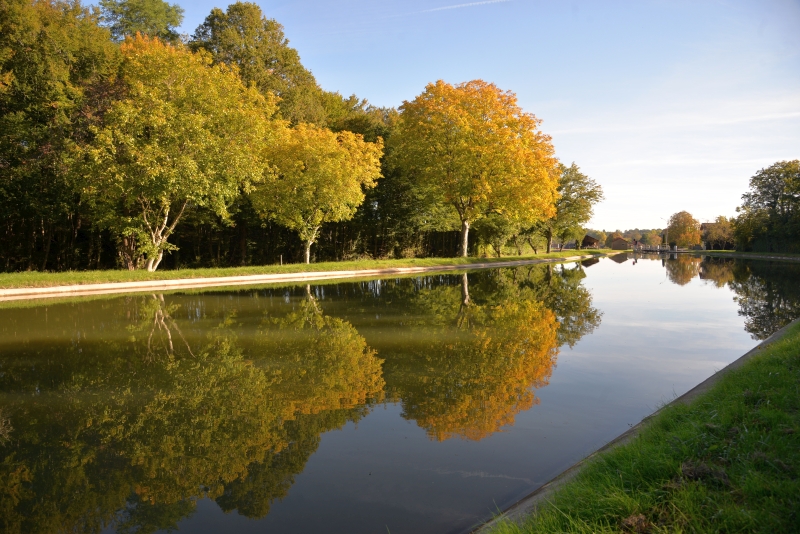
Places of Interest on the Canal de Briare
Famous today for its faïence, Gien is a prosperous town on the banks of the River Loire. Its château, once inhabited by Anne of Austria, mother of Louis XIV, is considered to be the northern most château of the Loire. The town was heavily damaged by the Luftwaffe during the Second World War and was subsequently the subject of the first major post-war redevelopment program in France.
The Château de Saint-Fargeau is a 17th-century, Renaissance château, originally built as a hunting residence in the 10th century. Destroyed in the 15th, it was replaced by a castle. This castle was itself destroyed by fire but promptly rebuilt in the 17th century, with additions and major improvements made in the 19th and 20th centuries.
The Château de Saint-Fargeau has a distinctive design. From above, the château’s curtains walls and towers form an irregular pentagon, the corners of which are formed by six towers of pink brick. Five of the towers are topped with lanterns. The château was designated as a historic monument in 1945 and has been open to the public since. A sound and light show has been organised each year at the château to raise funds for additional restorations. It lasts two hours and traces more than 1,000 years of history from Joan of Arc to the French Revolution. This production has taken place for more than 25 years and involves over 700 actors and 50 horse riders from the surrounding community.

The Château of Sully-sur-Loire was first built as a defensive fort to protect one of the few places where the Loire can be forded, and today is one of the most impressive and picturesque châteaux in the region.
With origins in the 11th century, the Château de Ratilly as we see it today was built on existing foundations in the 13th century. Today Ratilly is a creative centre for the arts and a pottery workshop, continuing a local tradition which has existed since the Roman occupation of France. The château was transformed into a fine residence during the Renaissance when many of its defences were no longer needed. Arrow slits were opened into large windows and some of the towers were developed for other purposes. We visit this wonderful Chateaux during our cruise aboard Renaissance on the Canal de Briare.
What may seem like a rather small and uninteresting little church is in fact one of the most important in Burgundy. The church of Saint Peter and Saint Paul in the village of Moutiers-en-Puisaye started life as a priory, built by monks in the 10th century in the Romanesque style. An 8th century hospice on the site took care of pilgrims, especially those from Brittany and England, who were travelling to Rome to visit the tomb of Saint Peter. The name Moutiers is derived from the French word for monk – moine.
During the Hundred Years War, a band of marauding Bretons travelling south destroyed the priory and the hospice but left the church standing. In the 19th century it was one of many studied by the French architect Eugène Viollet-Le-Duc and as such was classified a historic monument in 1862. What Viollet-le-Duc didn’t know, however, was that under the white washed plaster walls the church was hiding an incredible secret.
In the spring of 1982, after a particularly dry and warm spell, cracks started to appear in the plaster and parts crumbled and fell off. Behind, colour and images began to appear. Over 10 years the 12th century murals and frescoes were restored, in part by an expert restorer of medieval iconography – Isao Takahashi.
The 200m2 of painted murals today are some of the most important in Burgundy. They describe in great detail scenes from the Bible, including Genesis, the Great Flood, Adam and Eve and Cain and Abel, as well as the life of Christ from the Nativity, the Baptism in the river Jordan and His subsequent crucifixion.
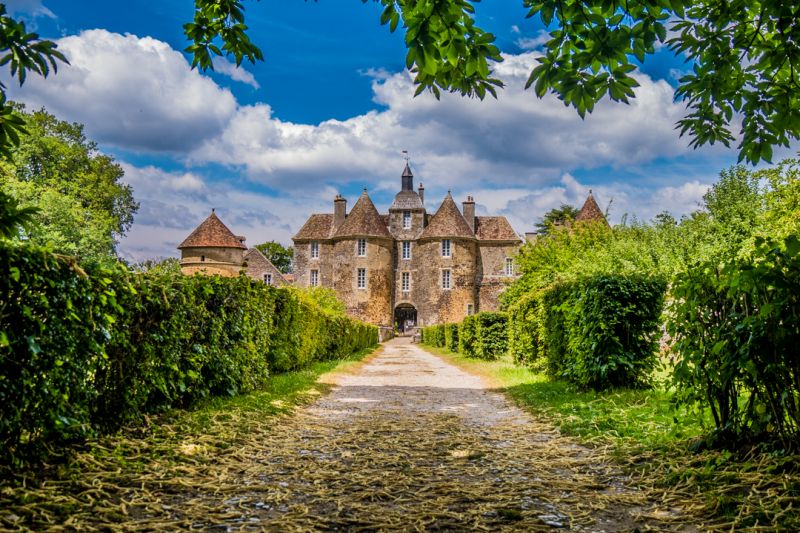
La Bussière takes its name from the wood it once grew, with Buxeria being Latin for a plantation of trees. The village lies on the edge of the old Roman road the Via Agrippa and several Roman artefacts have been found in its locale. The château was built in the 12th century by the local Lord, Stephen de Feins. Being well situated on the road running from the Loire Valley and Paris, the village soon became a postal stop and a commercial hub with much of its income going to the estate of the château.
During the French Wars of Religion of the 16th century, La Bussière was a Catholic stronghold, whereas the neighbouring town of Gien was largely Protestant. In 1567, a group of Huguenots attacked the village and killed 17 Catholic priests, damaging the château in the process. The château was rebuilt in the 17th century and was enclosed by the pond and gardens, designed by Louis XIV’s chief gardener André Le Nôtre. After the French Revolution, the castle changed hands several times until eventually it was sold to the current owners, who have lived in and maintained the property for over 200 years.
Lavishly decorated by the finest craftsmen and architects in Europe, the Château of Fontainebleau was truly the greatest residence of the Kings of France. Francis I brought the Italianate style, known as the Renaissance, to France while overseeing the construction of the palace, whereas Henri IV created magnificent gardens in and around the forest which surround it. Every monarch from Louis VII to Napoleon III has put their mark on the palace and today it radiates with the Kings’ ideals of wealth, luxury and elegance.
Moret-sur-Loing is a fortified town on the banks of the River Loing. Once part of the Royal Domaine, it found its fame while the Impressionist painter Alfred Sisley lived within its ancent walls in the 19th century. Sisley painted many rural and industrial scenes around Moret-sur-Loing and today is recognised as one of the most important English Impressionist artists.
Once the Capital of the Province of Berry, the city of Bourges has an intriguing architectural history. The Cathedral is considered as being one of the earliest examples of the high Gothic style in the 13th century while the Palace built for Jacques Coeur is still one of the finest examples of medieval architecture in France. The city has remained well preserved with many half-timbered buildings and fine town houses.
Situated on the River Loire, Orléans is most famously attributed as being the home of Joan of Arc and as the site of the Siege of Orléans which initiated the end of the Hundred Years War. Today it is a shining example of French medieval architecture and the 13th century cathedral is one of the most beautiful in France.
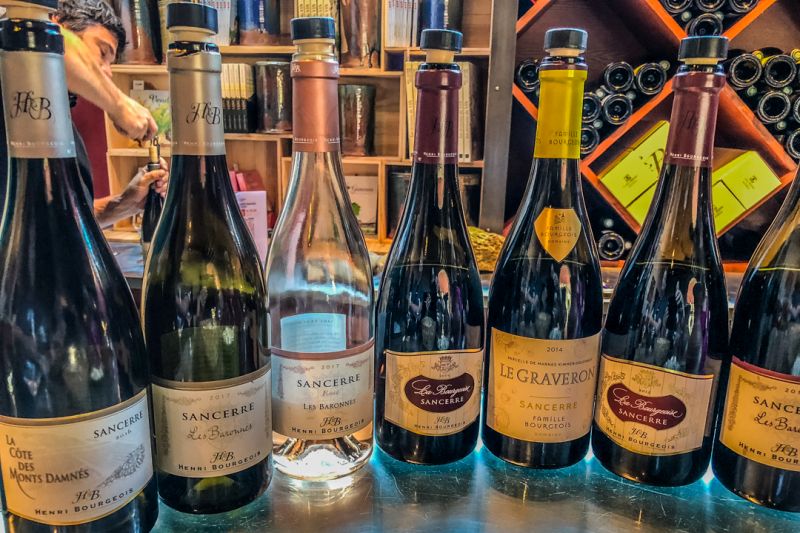
Perched high on a hill overlooking its famous, eponymous, wine growing region, Sancerre was first founded by the Romans. It is thought its name comes from the phrase “San Caesar”, meaning Caesar’s Temple. During the Religious Wars of the 16th century, Sancerre was a protestant stronghold and was able to fight off many Catholic attempts to besiege it and during the French Revolution, the town was a Royalist stronghold. Sancerre was the local command centre for the French Resistance throughout the Second World War and, although the Germans occupied the area, the resistance were able to continue their work.
Built in the 19th century by Compte Lafond in a variety of architectural styles, including Renaissance, Bavarian and Gothic, the Château du Nozet is one of the most romantic châteaux of the Loire. It has been the seat of the Ladoucette family for over 200 years, and is surrounded by over 160 hectares of some of the most prestigious vineyards in the Loire.
Situated on the ancient pilgrimage route to Saint James of Compostella in western Spain, La Charité-sur-Loire is a beautifully preserved medieval town and today a UNESCO World Heritage Site.
Ready to Explore the Historic Canal de Briare?
Guests aboard luxury hotel barges Renaissance will have the opportunity to visit many of the sites listed above. For more information on our Canal de Briare itineraries and the rest of our collection of luxury hotel barge cruises, why not order a free copy of our brochure today or speak to a member of our team directly using our handy Contact Form.
 English
English
 Spanish
Spanish French
French German
German Norwegian
Norwegian Portuguese
Portuguese Swedish
Swedish Italian
Italian Russian
Russian Simplified Chinese
Simplified Chinese Japanese
Japanese